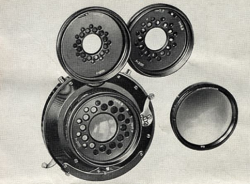- Joined
- Dec 19, 2017
- Messages
- 2,712
Hi Ken,
Always interesting to me how LF photographers wind up with the gear s/he uses. I started with 4x5 way back in 1979 when I bought my first outfit; a modified Wista/Tachihara from Zone VI Studios along with all the fixins to practice LF photography. I used that happily for years until I invested in 8x10 and wanted to use my 300mm lens with both cameras. Being that my 4x5 only has about 12.5" of bellows draw (yep, I still own that camera!), I could only focus pretty much at infinity and it wasn't the sturdiest beast racked all the way out. Later on, desiring an even more portable and lighter setup I bought a Toho FC-45X which reportedly had nearly 15" of bellows draw. I thought...hmm...could make pretty good use of the 300 with that extension. Well...it does extend to that length, but not easily and the bellows is about as taut as a snare drum at that length!
Therefore, even years and years later I really didn't have a 4x5 setup that would allow me to comfortably use that 300 and I kind of resigned myself to that fact. Then, a recognizable name (and fairly major camera guy) on one of the forums here (USA) listed a sorta Arca-Swiss F line camera for sale. I say "sorta" because it had the highly desirable telescoping monorail, brand new long bellows, and front/rear format frames of the F line, but base controls from the B era. It also had the desirable (to me) 4x5 rear standard, but 6x9 front standard. Anyway, long story short I bought it and couldn't be happier! It allows me to use the 300 with ease, and with extension rail and that long bellows I can even use my Fuji C 450mm! Don't have much extension available beyond infinity with that lens, but it's usable if I need it. I eventually bought a bag bellows for it which allows me to use my 75mm with ease. Yeah, that's another great feature that I never had...interchangeable bellows. And, to put a bit more "frosting on the cake" the camera weighs in at only 5.5 lbs!
I've always heard the Sinar's were great cameras--never owned one myself--but over the years I've used and/or played with a few other monorails and not a one comes even close to the Arca-Swiss. If I'm not packing the 8x10 (my usual format), then the Arca-Swiss comes with me every time!
Like you I bought a 300mm to use with my Wista in the late 1980's, in my case a 300mm Nikkor M, small light and in theory practical, and I was planning to move to 10x8 as well although that finally happened overv20 years later. I probably only used it twice, at full extension the bellows act as a sail, and the camera is too unstable.
I still had my De Vere monorail camera so in theory could have used that, but it wasn't practical out in the landscape where I'd often be out many hours on foot away from my car, working from a backpack. It was maybe 5 years ago I bought an ex military 14" (420mm) f5.6 telephoto lens at a flea market, coated it's almost certainly made by Dallmeyer. After calculating and making an aperture scale I used this on a Speed Graphic as the lens has no shutter, it's great for specific shots but was still not practical to use with my Wista.
About a year later I saw a Schneider 360mm f5.5 Tele Xenar for sale on a Forum at a good price, and I'd dealt with the seller before so I bought it. It's a lovely lens to use with the Wista, very practical because it needs little bellows draw as the flange focal distance is only 214mmm. For the first time I'm working on a project where I really need to use longer FL lenses on my 5x4 and it was the Dallmeyer 14" telephoto that opened the way.
Ian


